ECON6001 Economic Principles: Evaluating Market Failure in Australia
VerifiedAdded on 2023/06/10
|12
|2542
|184
Case Study
AI Summary
This report analyzes market failure in the Australian energy market, characterized by an oligopolistic structure dominated by a few large players. The focus is on the energy sector, where despite abundant gas reserves, Australia faces power shortages due to prioritizing exports over domestic needs, leading to higher prices and potential blackouts. The study highlights the consequences of this market failure on society and examines government interventions aimed at correcting the imbalance, such as the Australian Domestic Gas Security Mechanism. It also contrasts market failures in developed and developing nations, emphasizing that developed nations are not immune to market failures, using Australia's energy market as a prime example. The report concludes that government intervention is necessary to protect societal interests and ensure efficient resource allocation in the face of private companies' self-interest.
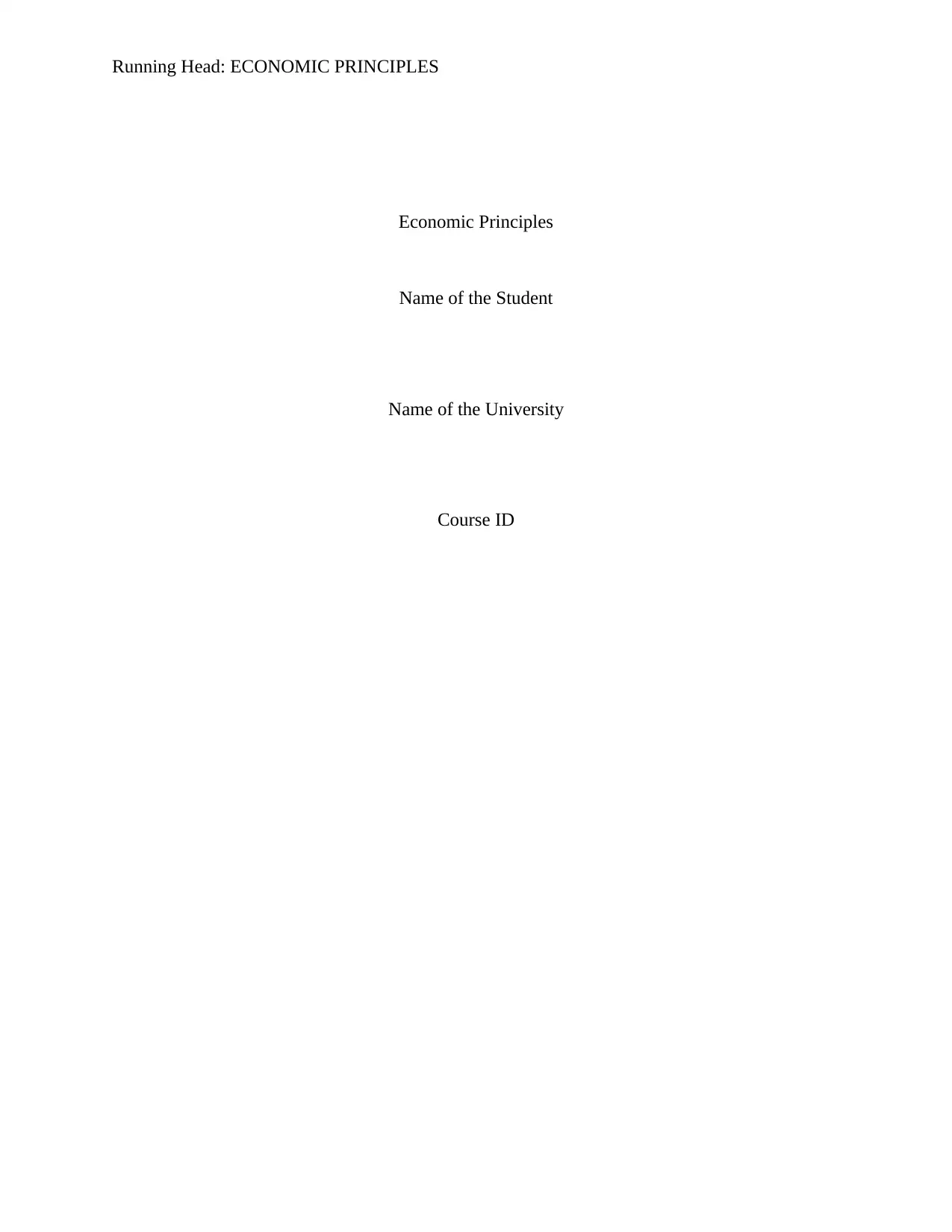
Running Head: ECONOMIC PRINCIPLES
Economic Principles
Name of the Student
Name of the University
Course ID
Economic Principles
Name of the Student
Name of the University
Course ID
Paraphrase This Document
Need a fresh take? Get an instant paraphrase of this document with our AI Paraphraser
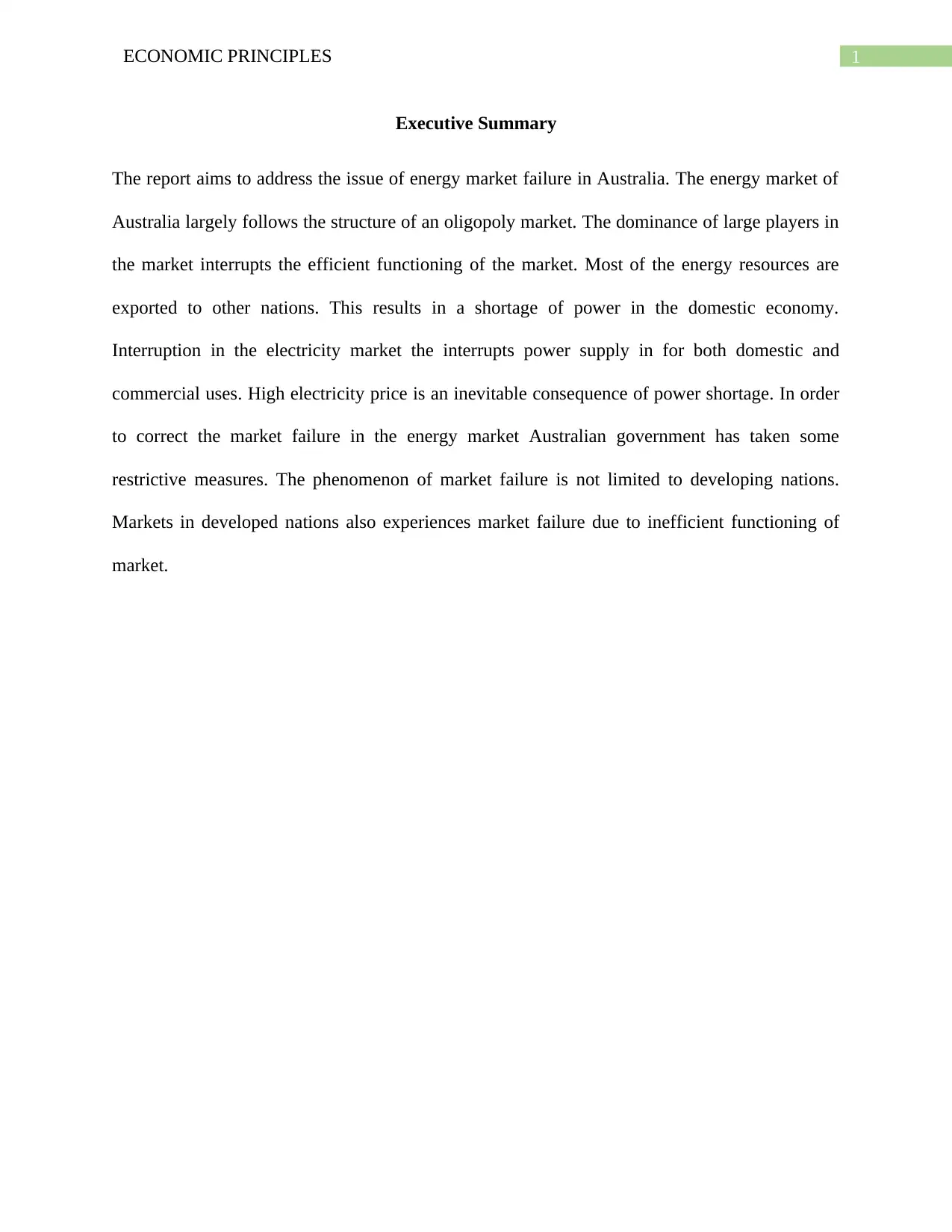
1ECONOMIC PRINCIPLES
Executive Summary
The report aims to address the issue of energy market failure in Australia. The energy market of
Australia largely follows the structure of an oligopoly market. The dominance of large players in
the market interrupts the efficient functioning of the market. Most of the energy resources are
exported to other nations. This results in a shortage of power in the domestic economy.
Interruption in the electricity market the interrupts power supply in for both domestic and
commercial uses. High electricity price is an inevitable consequence of power shortage. In order
to correct the market failure in the energy market Australian government has taken some
restrictive measures. The phenomenon of market failure is not limited to developing nations.
Markets in developed nations also experiences market failure due to inefficient functioning of
market.
Executive Summary
The report aims to address the issue of energy market failure in Australia. The energy market of
Australia largely follows the structure of an oligopoly market. The dominance of large players in
the market interrupts the efficient functioning of the market. Most of the energy resources are
exported to other nations. This results in a shortage of power in the domestic economy.
Interruption in the electricity market the interrupts power supply in for both domestic and
commercial uses. High electricity price is an inevitable consequence of power shortage. In order
to correct the market failure in the energy market Australian government has taken some
restrictive measures. The phenomenon of market failure is not limited to developing nations.
Markets in developed nations also experiences market failure due to inefficient functioning of
market.
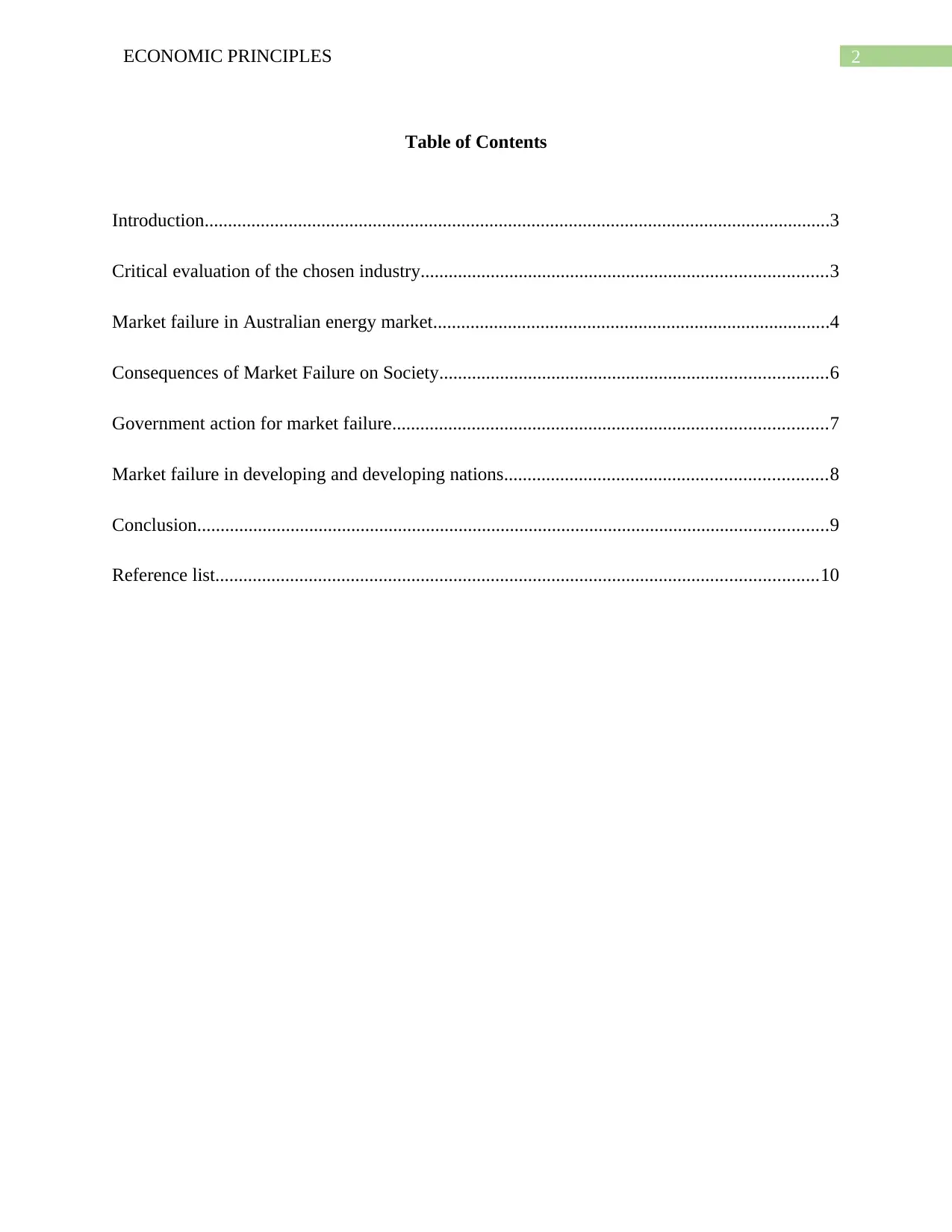
2ECONOMIC PRINCIPLES
Table of Contents
Introduction......................................................................................................................................3
Critical evaluation of the chosen industry.......................................................................................3
Market failure in Australian energy market.....................................................................................4
Consequences of Market Failure on Society...................................................................................6
Government action for market failure.............................................................................................7
Market failure in developing and developing nations.....................................................................8
Conclusion.......................................................................................................................................9
Reference list.................................................................................................................................10
Table of Contents
Introduction......................................................................................................................................3
Critical evaluation of the chosen industry.......................................................................................3
Market failure in Australian energy market.....................................................................................4
Consequences of Market Failure on Society...................................................................................6
Government action for market failure.............................................................................................7
Market failure in developing and developing nations.....................................................................8
Conclusion.......................................................................................................................................9
Reference list.................................................................................................................................10
⊘ This is a preview!⊘
Do you want full access?
Subscribe today to unlock all pages.

Trusted by 1+ million students worldwide
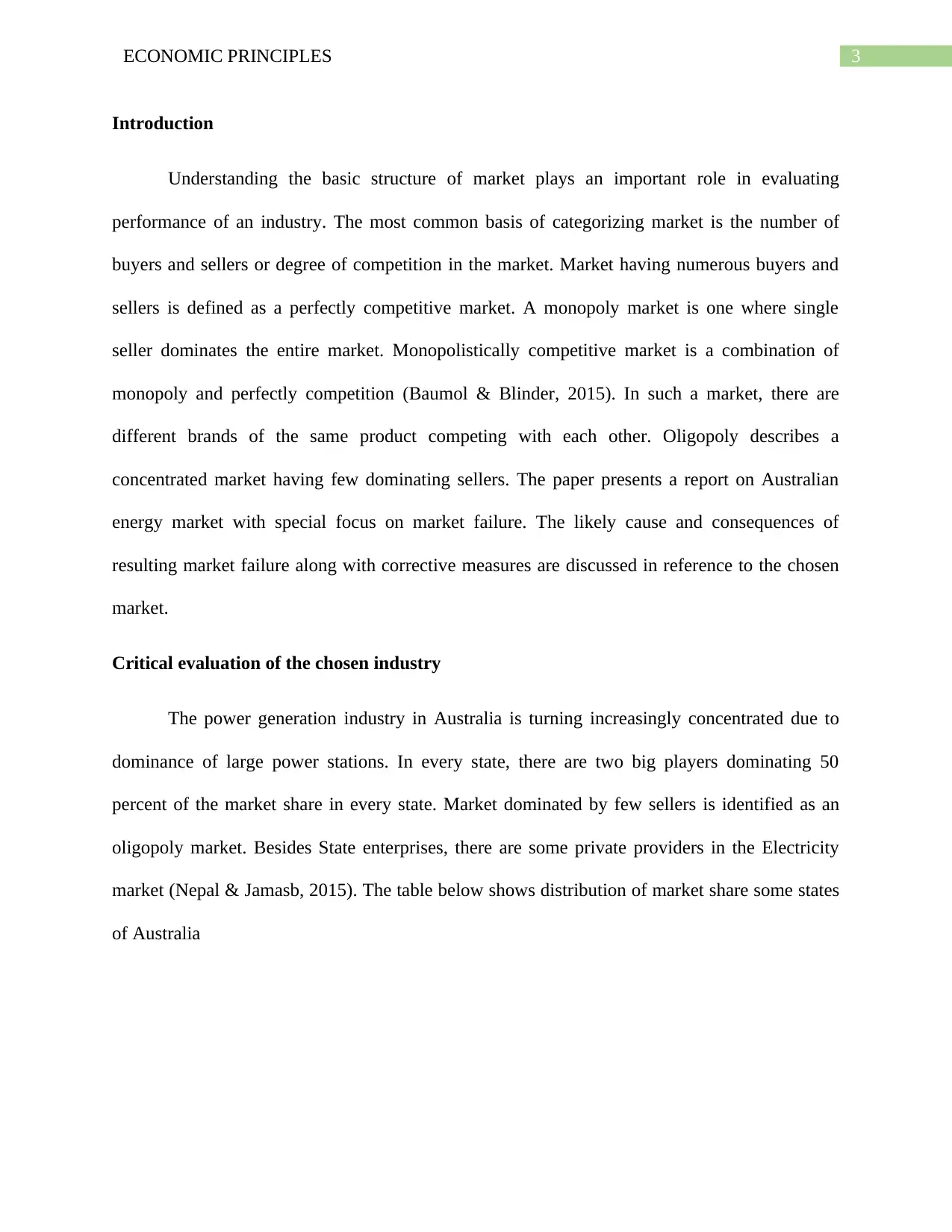
3ECONOMIC PRINCIPLES
Introduction
Understanding the basic structure of market plays an important role in evaluating
performance of an industry. The most common basis of categorizing market is the number of
buyers and sellers or degree of competition in the market. Market having numerous buyers and
sellers is defined as a perfectly competitive market. A monopoly market is one where single
seller dominates the entire market. Monopolistically competitive market is a combination of
monopoly and perfectly competition (Baumol & Blinder, 2015). In such a market, there are
different brands of the same product competing with each other. Oligopoly describes a
concentrated market having few dominating sellers. The paper presents a report on Australian
energy market with special focus on market failure. The likely cause and consequences of
resulting market failure along with corrective measures are discussed in reference to the chosen
market.
Critical evaluation of the chosen industry
The power generation industry in Australia is turning increasingly concentrated due to
dominance of large power stations. In every state, there are two big players dominating 50
percent of the market share in every state. Market dominated by few sellers is identified as an
oligopoly market. Besides State enterprises, there are some private providers in the Electricity
market (Nepal & Jamasb, 2015). The table below shows distribution of market share some states
of Australia
Introduction
Understanding the basic structure of market plays an important role in evaluating
performance of an industry. The most common basis of categorizing market is the number of
buyers and sellers or degree of competition in the market. Market having numerous buyers and
sellers is defined as a perfectly competitive market. A monopoly market is one where single
seller dominates the entire market. Monopolistically competitive market is a combination of
monopoly and perfectly competition (Baumol & Blinder, 2015). In such a market, there are
different brands of the same product competing with each other. Oligopoly describes a
concentrated market having few dominating sellers. The paper presents a report on Australian
energy market with special focus on market failure. The likely cause and consequences of
resulting market failure along with corrective measures are discussed in reference to the chosen
market.
Critical evaluation of the chosen industry
The power generation industry in Australia is turning increasingly concentrated due to
dominance of large power stations. In every state, there are two big players dominating 50
percent of the market share in every state. Market dominated by few sellers is identified as an
oligopoly market. Besides State enterprises, there are some private providers in the Electricity
market (Nepal & Jamasb, 2015). The table below shows distribution of market share some states
of Australia
Paraphrase This Document
Need a fresh take? Get an instant paraphrase of this document with our AI Paraphraser
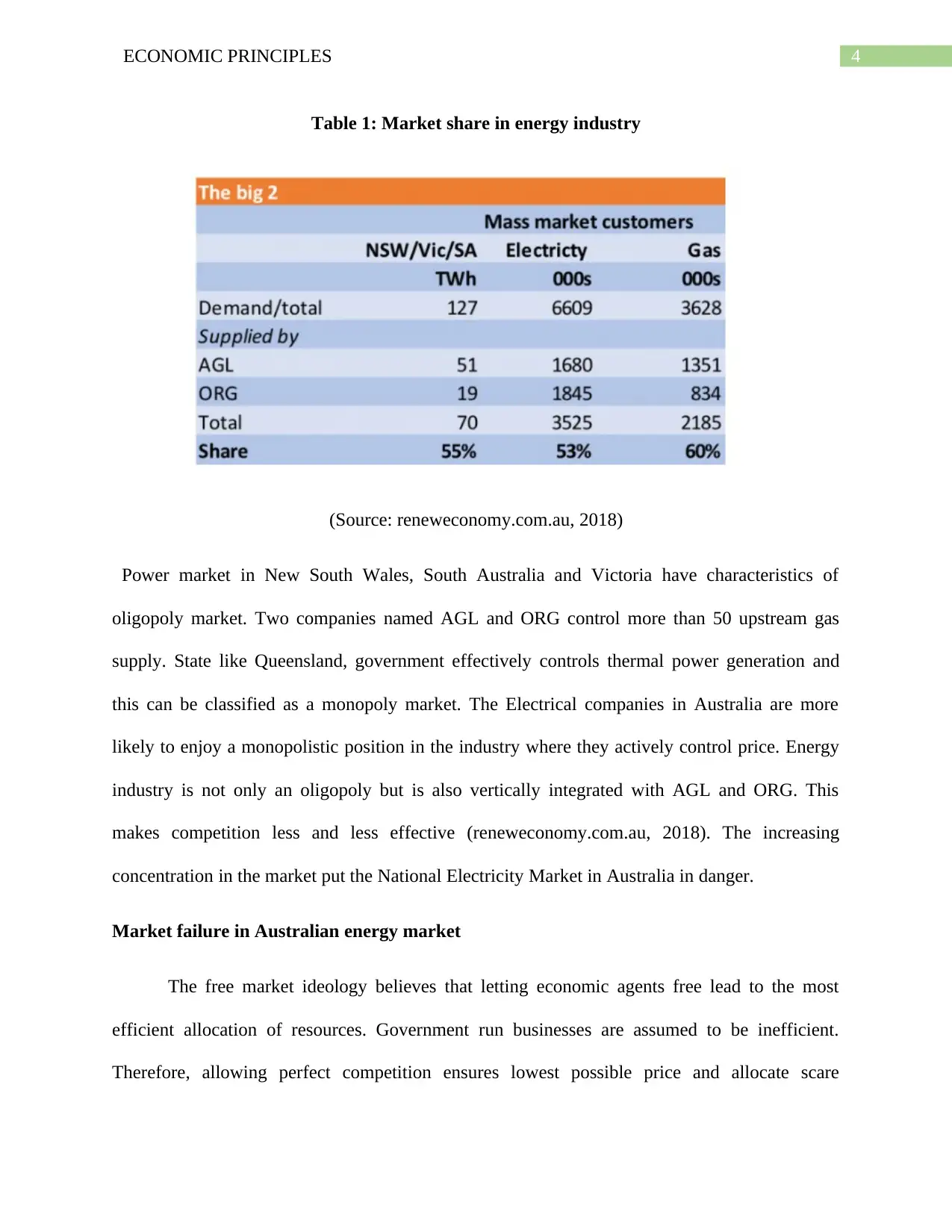
4ECONOMIC PRINCIPLES
Table 1: Market share in energy industry
(Source: reneweconomy.com.au, 2018)
Power market in New South Wales, South Australia and Victoria have characteristics of
oligopoly market. Two companies named AGL and ORG control more than 50 upstream gas
supply. State like Queensland, government effectively controls thermal power generation and
this can be classified as a monopoly market. The Electrical companies in Australia are more
likely to enjoy a monopolistic position in the industry where they actively control price. Energy
industry is not only an oligopoly but is also vertically integrated with AGL and ORG. This
makes competition less and less effective (reneweconomy.com.au, 2018). The increasing
concentration in the market put the National Electricity Market in Australia in danger.
Market failure in Australian energy market
The free market ideology believes that letting economic agents free lead to the most
efficient allocation of resources. Government run businesses are assumed to be inefficient.
Therefore, allowing perfect competition ensures lowest possible price and allocate scare
Table 1: Market share in energy industry
(Source: reneweconomy.com.au, 2018)
Power market in New South Wales, South Australia and Victoria have characteristics of
oligopoly market. Two companies named AGL and ORG control more than 50 upstream gas
supply. State like Queensland, government effectively controls thermal power generation and
this can be classified as a monopoly market. The Electrical companies in Australia are more
likely to enjoy a monopolistic position in the industry where they actively control price. Energy
industry is not only an oligopoly but is also vertically integrated with AGL and ORG. This
makes competition less and less effective (reneweconomy.com.au, 2018). The increasing
concentration in the market put the National Electricity Market in Australia in danger.
Market failure in Australian energy market
The free market ideology believes that letting economic agents free lead to the most
efficient allocation of resources. Government run businesses are assumed to be inefficient.
Therefore, allowing perfect competition ensures lowest possible price and allocate scare
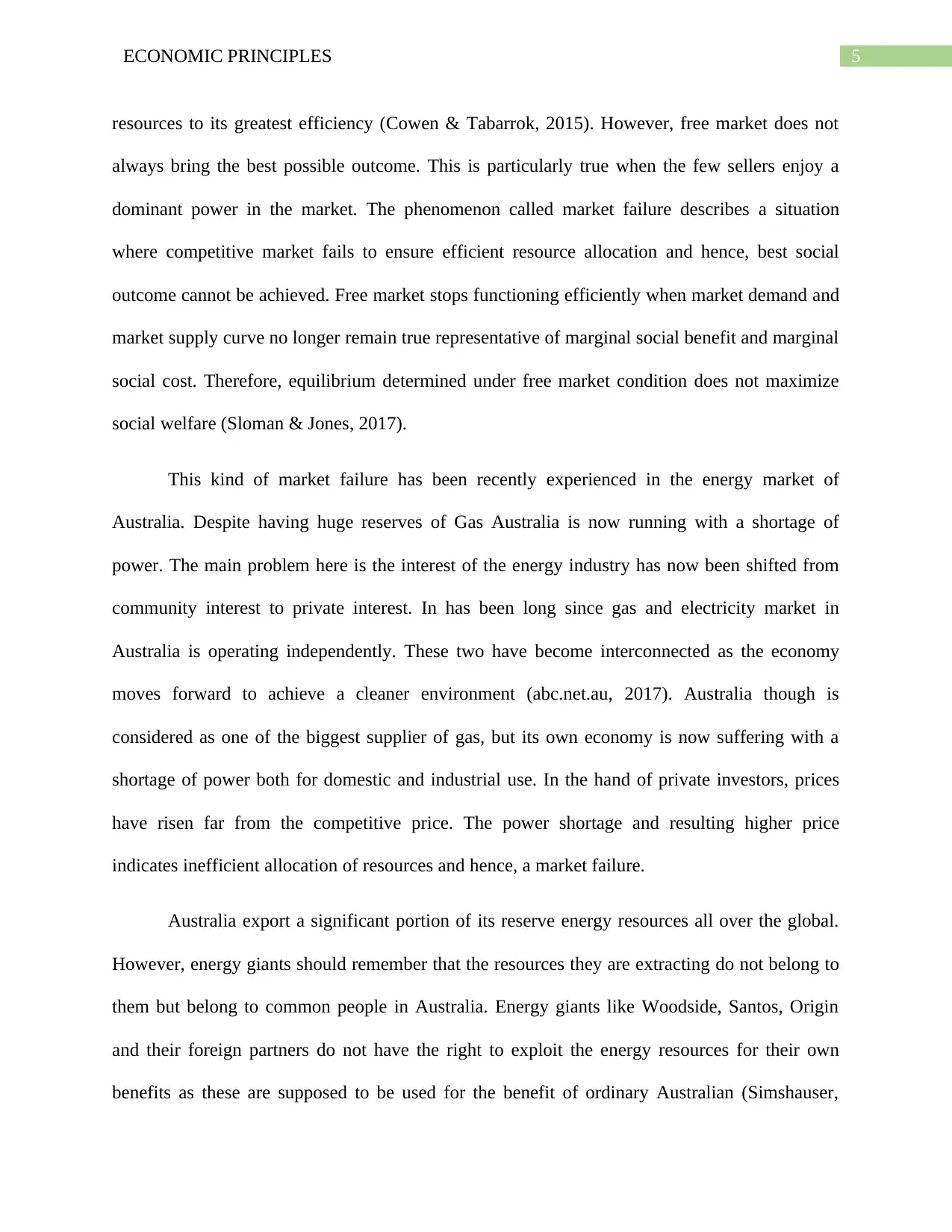
5ECONOMIC PRINCIPLES
resources to its greatest efficiency (Cowen & Tabarrok, 2015). However, free market does not
always bring the best possible outcome. This is particularly true when the few sellers enjoy a
dominant power in the market. The phenomenon called market failure describes a situation
where competitive market fails to ensure efficient resource allocation and hence, best social
outcome cannot be achieved. Free market stops functioning efficiently when market demand and
market supply curve no longer remain true representative of marginal social benefit and marginal
social cost. Therefore, equilibrium determined under free market condition does not maximize
social welfare (Sloman & Jones, 2017).
This kind of market failure has been recently experienced in the energy market of
Australia. Despite having huge reserves of Gas Australia is now running with a shortage of
power. The main problem here is the interest of the energy industry has now been shifted from
community interest to private interest. In has been long since gas and electricity market in
Australia is operating independently. These two have become interconnected as the economy
moves forward to achieve a cleaner environment (abc.net.au, 2017). Australia though is
considered as one of the biggest supplier of gas, but its own economy is now suffering with a
shortage of power both for domestic and industrial use. In the hand of private investors, prices
have risen far from the competitive price. The power shortage and resulting higher price
indicates inefficient allocation of resources and hence, a market failure.
Australia export a significant portion of its reserve energy resources all over the global.
However, energy giants should remember that the resources they are extracting do not belong to
them but belong to common people in Australia. Energy giants like Woodside, Santos, Origin
and their foreign partners do not have the right to exploit the energy resources for their own
benefits as these are supposed to be used for the benefit of ordinary Australian (Simshauser,
resources to its greatest efficiency (Cowen & Tabarrok, 2015). However, free market does not
always bring the best possible outcome. This is particularly true when the few sellers enjoy a
dominant power in the market. The phenomenon called market failure describes a situation
where competitive market fails to ensure efficient resource allocation and hence, best social
outcome cannot be achieved. Free market stops functioning efficiently when market demand and
market supply curve no longer remain true representative of marginal social benefit and marginal
social cost. Therefore, equilibrium determined under free market condition does not maximize
social welfare (Sloman & Jones, 2017).
This kind of market failure has been recently experienced in the energy market of
Australia. Despite having huge reserves of Gas Australia is now running with a shortage of
power. The main problem here is the interest of the energy industry has now been shifted from
community interest to private interest. In has been long since gas and electricity market in
Australia is operating independently. These two have become interconnected as the economy
moves forward to achieve a cleaner environment (abc.net.au, 2017). Australia though is
considered as one of the biggest supplier of gas, but its own economy is now suffering with a
shortage of power both for domestic and industrial use. In the hand of private investors, prices
have risen far from the competitive price. The power shortage and resulting higher price
indicates inefficient allocation of resources and hence, a market failure.
Australia export a significant portion of its reserve energy resources all over the global.
However, energy giants should remember that the resources they are extracting do not belong to
them but belong to common people in Australia. Energy giants like Woodside, Santos, Origin
and their foreign partners do not have the right to exploit the energy resources for their own
benefits as these are supposed to be used for the benefit of ordinary Australian (Simshauser,
⊘ This is a preview!⊘
Do you want full access?
Subscribe today to unlock all pages.

Trusted by 1+ million students worldwide
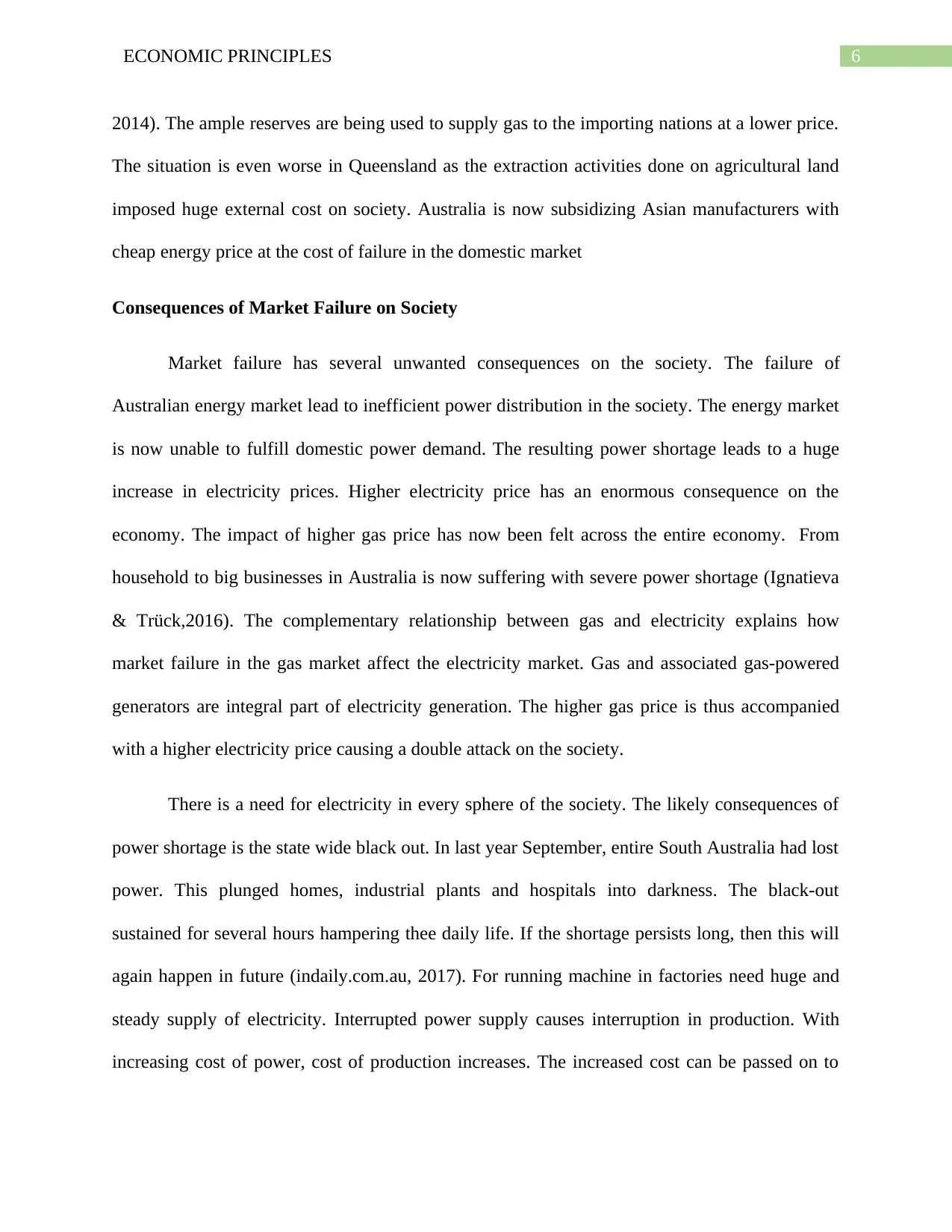
6ECONOMIC PRINCIPLES
2014). The ample reserves are being used to supply gas to the importing nations at a lower price.
The situation is even worse in Queensland as the extraction activities done on agricultural land
imposed huge external cost on society. Australia is now subsidizing Asian manufacturers with
cheap energy price at the cost of failure in the domestic market
Consequences of Market Failure on Society
Market failure has several unwanted consequences on the society. The failure of
Australian energy market lead to inefficient power distribution in the society. The energy market
is now unable to fulfill domestic power demand. The resulting power shortage leads to a huge
increase in electricity prices. Higher electricity price has an enormous consequence on the
economy. The impact of higher gas price has now been felt across the entire economy. From
household to big businesses in Australia is now suffering with severe power shortage (Ignatieva
& Trück,2016). The complementary relationship between gas and electricity explains how
market failure in the gas market affect the electricity market. Gas and associated gas-powered
generators are integral part of electricity generation. The higher gas price is thus accompanied
with a higher electricity price causing a double attack on the society.
There is a need for electricity in every sphere of the society. The likely consequences of
power shortage is the state wide black out. In last year September, entire South Australia had lost
power. This plunged homes, industrial plants and hospitals into darkness. The black-out
sustained for several hours hampering thee daily life. If the shortage persists long, then this will
again happen in future (indaily.com.au, 2017). For running machine in factories need huge and
steady supply of electricity. Interrupted power supply causes interruption in production. With
increasing cost of power, cost of production increases. The increased cost can be passed on to
2014). The ample reserves are being used to supply gas to the importing nations at a lower price.
The situation is even worse in Queensland as the extraction activities done on agricultural land
imposed huge external cost on society. Australia is now subsidizing Asian manufacturers with
cheap energy price at the cost of failure in the domestic market
Consequences of Market Failure on Society
Market failure has several unwanted consequences on the society. The failure of
Australian energy market lead to inefficient power distribution in the society. The energy market
is now unable to fulfill domestic power demand. The resulting power shortage leads to a huge
increase in electricity prices. Higher electricity price has an enormous consequence on the
economy. The impact of higher gas price has now been felt across the entire economy. From
household to big businesses in Australia is now suffering with severe power shortage (Ignatieva
& Trück,2016). The complementary relationship between gas and electricity explains how
market failure in the gas market affect the electricity market. Gas and associated gas-powered
generators are integral part of electricity generation. The higher gas price is thus accompanied
with a higher electricity price causing a double attack on the society.
There is a need for electricity in every sphere of the society. The likely consequences of
power shortage is the state wide black out. In last year September, entire South Australia had lost
power. This plunged homes, industrial plants and hospitals into darkness. The black-out
sustained for several hours hampering thee daily life. If the shortage persists long, then this will
again happen in future (indaily.com.au, 2017). For running machine in factories need huge and
steady supply of electricity. Interrupted power supply causes interruption in production. With
increasing cost of power, cost of production increases. The increased cost can be passed on to
Paraphrase This Document
Need a fresh take? Get an instant paraphrase of this document with our AI Paraphraser
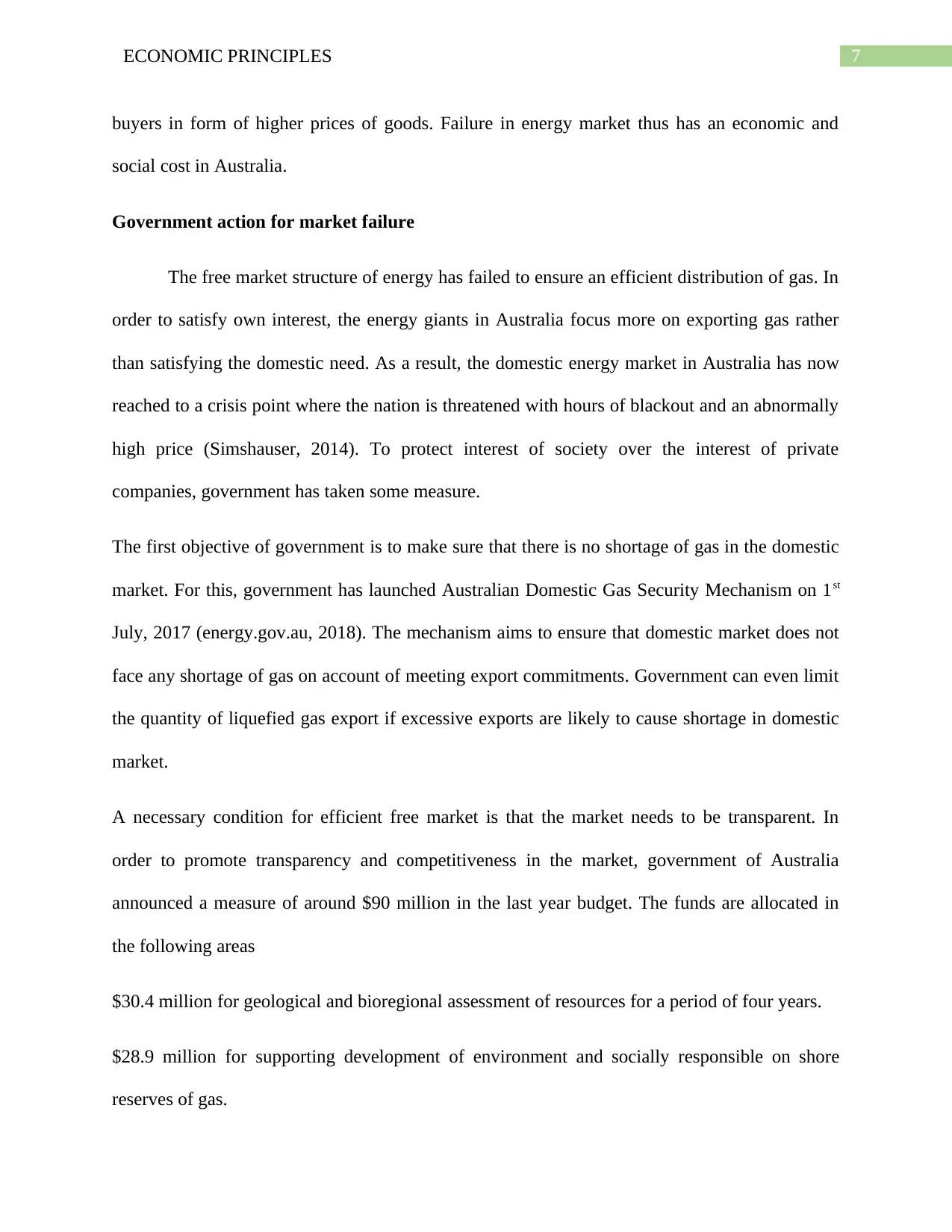
7ECONOMIC PRINCIPLES
buyers in form of higher prices of goods. Failure in energy market thus has an economic and
social cost in Australia.
Government action for market failure
The free market structure of energy has failed to ensure an efficient distribution of gas. In
order to satisfy own interest, the energy giants in Australia focus more on exporting gas rather
than satisfying the domestic need. As a result, the domestic energy market in Australia has now
reached to a crisis point where the nation is threatened with hours of blackout and an abnormally
high price (Simshauser, 2014). To protect interest of society over the interest of private
companies, government has taken some measure.
The first objective of government is to make sure that there is no shortage of gas in the domestic
market. For this, government has launched Australian Domestic Gas Security Mechanism on 1st
July, 2017 (energy.gov.au, 2018). The mechanism aims to ensure that domestic market does not
face any shortage of gas on account of meeting export commitments. Government can even limit
the quantity of liquefied gas export if excessive exports are likely to cause shortage in domestic
market.
A necessary condition for efficient free market is that the market needs to be transparent. In
order to promote transparency and competitiveness in the market, government of Australia
announced a measure of around $90 million in the last year budget. The funds are allocated in
the following areas
$30.4 million for geological and bioregional assessment of resources for a period of four years.
$28.9 million for supporting development of environment and socially responsible on shore
reserves of gas.
buyers in form of higher prices of goods. Failure in energy market thus has an economic and
social cost in Australia.
Government action for market failure
The free market structure of energy has failed to ensure an efficient distribution of gas. In
order to satisfy own interest, the energy giants in Australia focus more on exporting gas rather
than satisfying the domestic need. As a result, the domestic energy market in Australia has now
reached to a crisis point where the nation is threatened with hours of blackout and an abnormally
high price (Simshauser, 2014). To protect interest of society over the interest of private
companies, government has taken some measure.
The first objective of government is to make sure that there is no shortage of gas in the domestic
market. For this, government has launched Australian Domestic Gas Security Mechanism on 1st
July, 2017 (energy.gov.au, 2018). The mechanism aims to ensure that domestic market does not
face any shortage of gas on account of meeting export commitments. Government can even limit
the quantity of liquefied gas export if excessive exports are likely to cause shortage in domestic
market.
A necessary condition for efficient free market is that the market needs to be transparent. In
order to promote transparency and competitiveness in the market, government of Australia
announced a measure of around $90 million in the last year budget. The funds are allocated in
the following areas
$30.4 million for geological and bioregional assessment of resources for a period of four years.
$28.9 million for supporting development of environment and socially responsible on shore
reserves of gas.
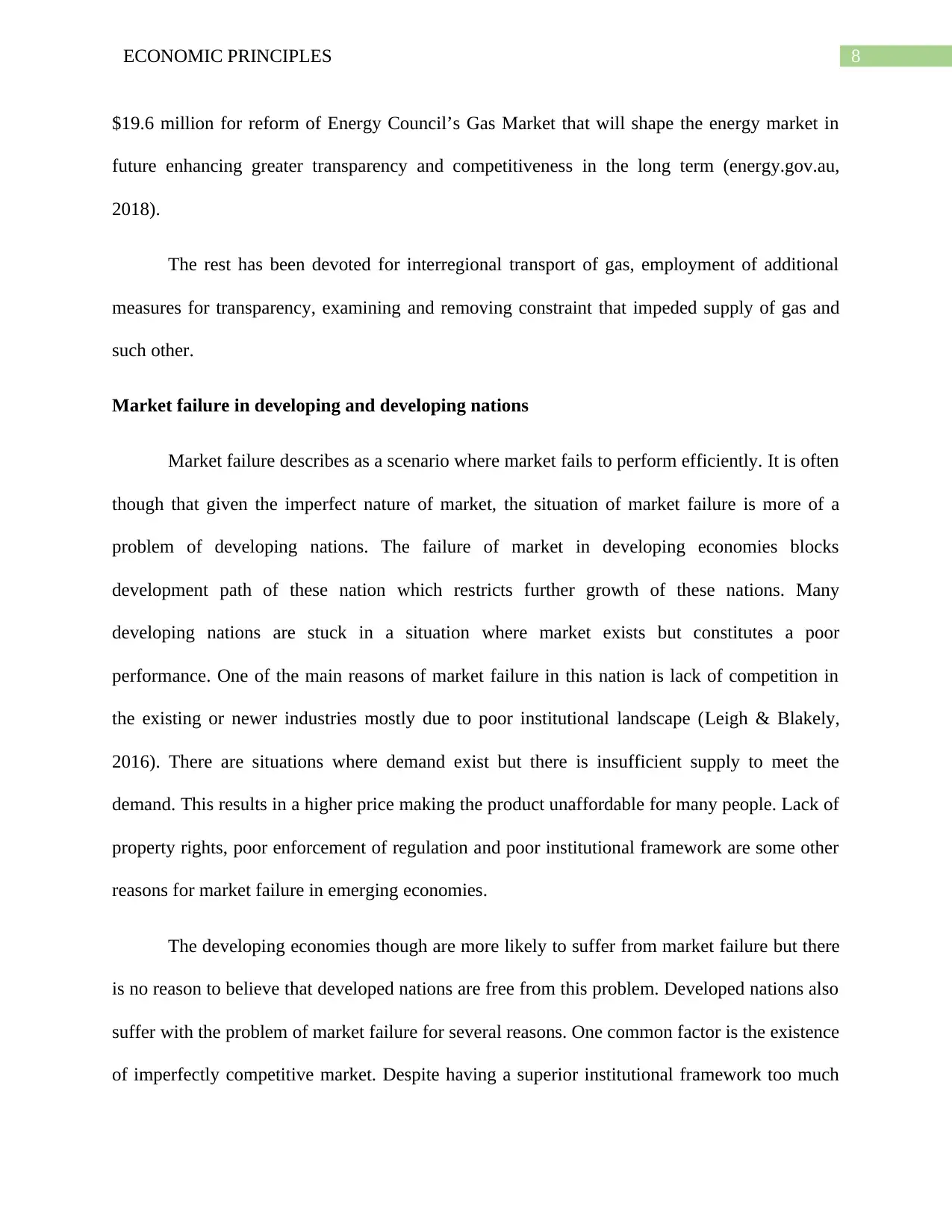
8ECONOMIC PRINCIPLES
$19.6 million for reform of Energy Council’s Gas Market that will shape the energy market in
future enhancing greater transparency and competitiveness in the long term (energy.gov.au,
2018).
The rest has been devoted for interregional transport of gas, employment of additional
measures for transparency, examining and removing constraint that impeded supply of gas and
such other.
Market failure in developing and developing nations
Market failure describes as a scenario where market fails to perform efficiently. It is often
though that given the imperfect nature of market, the situation of market failure is more of a
problem of developing nations. The failure of market in developing economies blocks
development path of these nation which restricts further growth of these nations. Many
developing nations are stuck in a situation where market exists but constitutes a poor
performance. One of the main reasons of market failure in this nation is lack of competition in
the existing or newer industries mostly due to poor institutional landscape (Leigh & Blakely,
2016). There are situations where demand exist but there is insufficient supply to meet the
demand. This results in a higher price making the product unaffordable for many people. Lack of
property rights, poor enforcement of regulation and poor institutional framework are some other
reasons for market failure in emerging economies.
The developing economies though are more likely to suffer from market failure but there
is no reason to believe that developed nations are free from this problem. Developed nations also
suffer with the problem of market failure for several reasons. One common factor is the existence
of imperfectly competitive market. Despite having a superior institutional framework too much
$19.6 million for reform of Energy Council’s Gas Market that will shape the energy market in
future enhancing greater transparency and competitiveness in the long term (energy.gov.au,
2018).
The rest has been devoted for interregional transport of gas, employment of additional
measures for transparency, examining and removing constraint that impeded supply of gas and
such other.
Market failure in developing and developing nations
Market failure describes as a scenario where market fails to perform efficiently. It is often
though that given the imperfect nature of market, the situation of market failure is more of a
problem of developing nations. The failure of market in developing economies blocks
development path of these nation which restricts further growth of these nations. Many
developing nations are stuck in a situation where market exists but constitutes a poor
performance. One of the main reasons of market failure in this nation is lack of competition in
the existing or newer industries mostly due to poor institutional landscape (Leigh & Blakely,
2016). There are situations where demand exist but there is insufficient supply to meet the
demand. This results in a higher price making the product unaffordable for many people. Lack of
property rights, poor enforcement of regulation and poor institutional framework are some other
reasons for market failure in emerging economies.
The developing economies though are more likely to suffer from market failure but there
is no reason to believe that developed nations are free from this problem. Developed nations also
suffer with the problem of market failure for several reasons. One common factor is the existence
of imperfectly competitive market. Despite having a superior institutional framework too much
⊘ This is a preview!⊘
Do you want full access?
Subscribe today to unlock all pages.

Trusted by 1+ million students worldwide
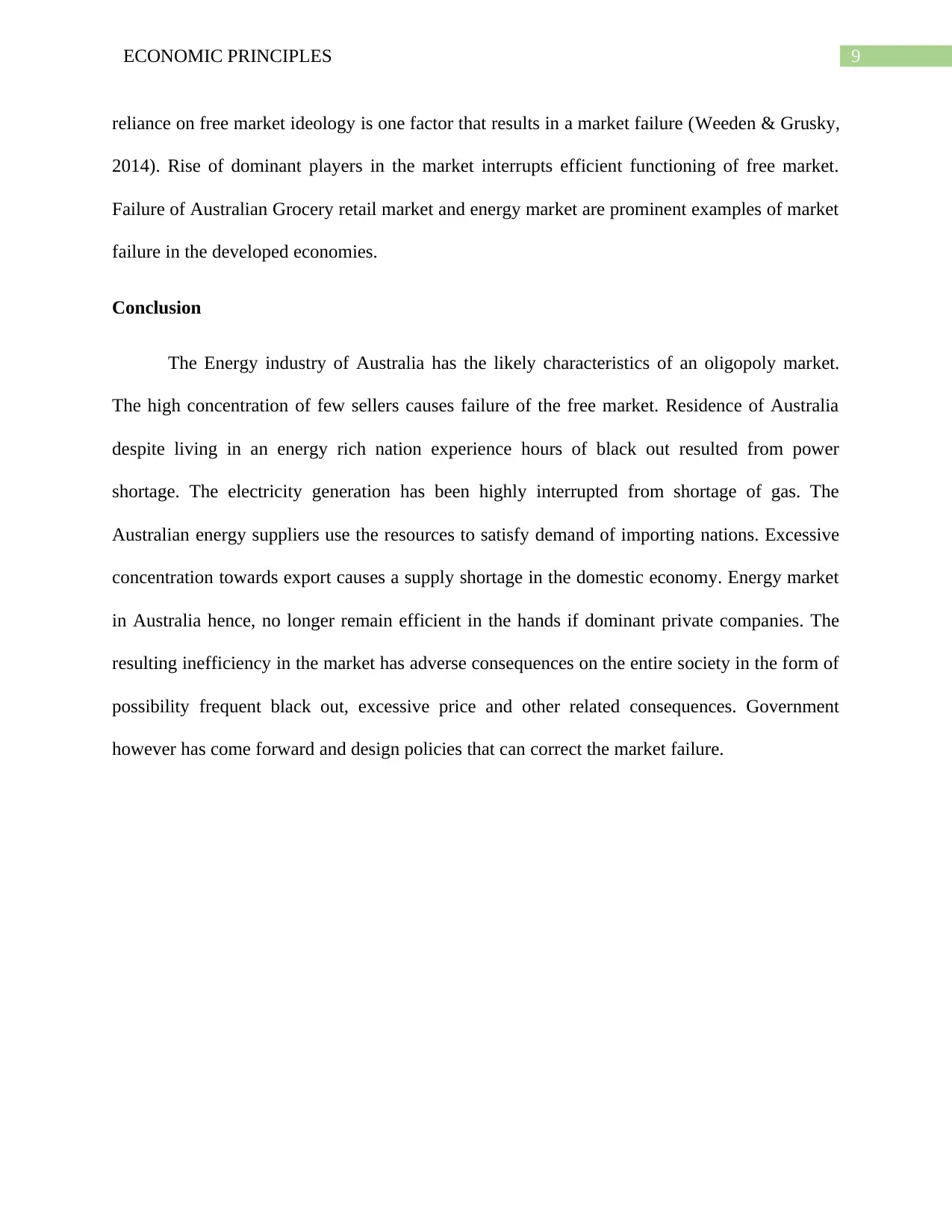
9ECONOMIC PRINCIPLES
reliance on free market ideology is one factor that results in a market failure (Weeden & Grusky,
2014). Rise of dominant players in the market interrupts efficient functioning of free market.
Failure of Australian Grocery retail market and energy market are prominent examples of market
failure in the developed economies.
Conclusion
The Energy industry of Australia has the likely characteristics of an oligopoly market.
The high concentration of few sellers causes failure of the free market. Residence of Australia
despite living in an energy rich nation experience hours of black out resulted from power
shortage. The electricity generation has been highly interrupted from shortage of gas. The
Australian energy suppliers use the resources to satisfy demand of importing nations. Excessive
concentration towards export causes a supply shortage in the domestic economy. Energy market
in Australia hence, no longer remain efficient in the hands if dominant private companies. The
resulting inefficiency in the market has adverse consequences on the entire society in the form of
possibility frequent black out, excessive price and other related consequences. Government
however has come forward and design policies that can correct the market failure.
reliance on free market ideology is one factor that results in a market failure (Weeden & Grusky,
2014). Rise of dominant players in the market interrupts efficient functioning of free market.
Failure of Australian Grocery retail market and energy market are prominent examples of market
failure in the developed economies.
Conclusion
The Energy industry of Australia has the likely characteristics of an oligopoly market.
The high concentration of few sellers causes failure of the free market. Residence of Australia
despite living in an energy rich nation experience hours of black out resulted from power
shortage. The electricity generation has been highly interrupted from shortage of gas. The
Australian energy suppliers use the resources to satisfy demand of importing nations. Excessive
concentration towards export causes a supply shortage in the domestic economy. Energy market
in Australia hence, no longer remain efficient in the hands if dominant private companies. The
resulting inefficiency in the market has adverse consequences on the entire society in the form of
possibility frequent black out, excessive price and other related consequences. Government
however has come forward and design policies that can correct the market failure.
Paraphrase This Document
Need a fresh take? Get an instant paraphrase of this document with our AI Paraphraser
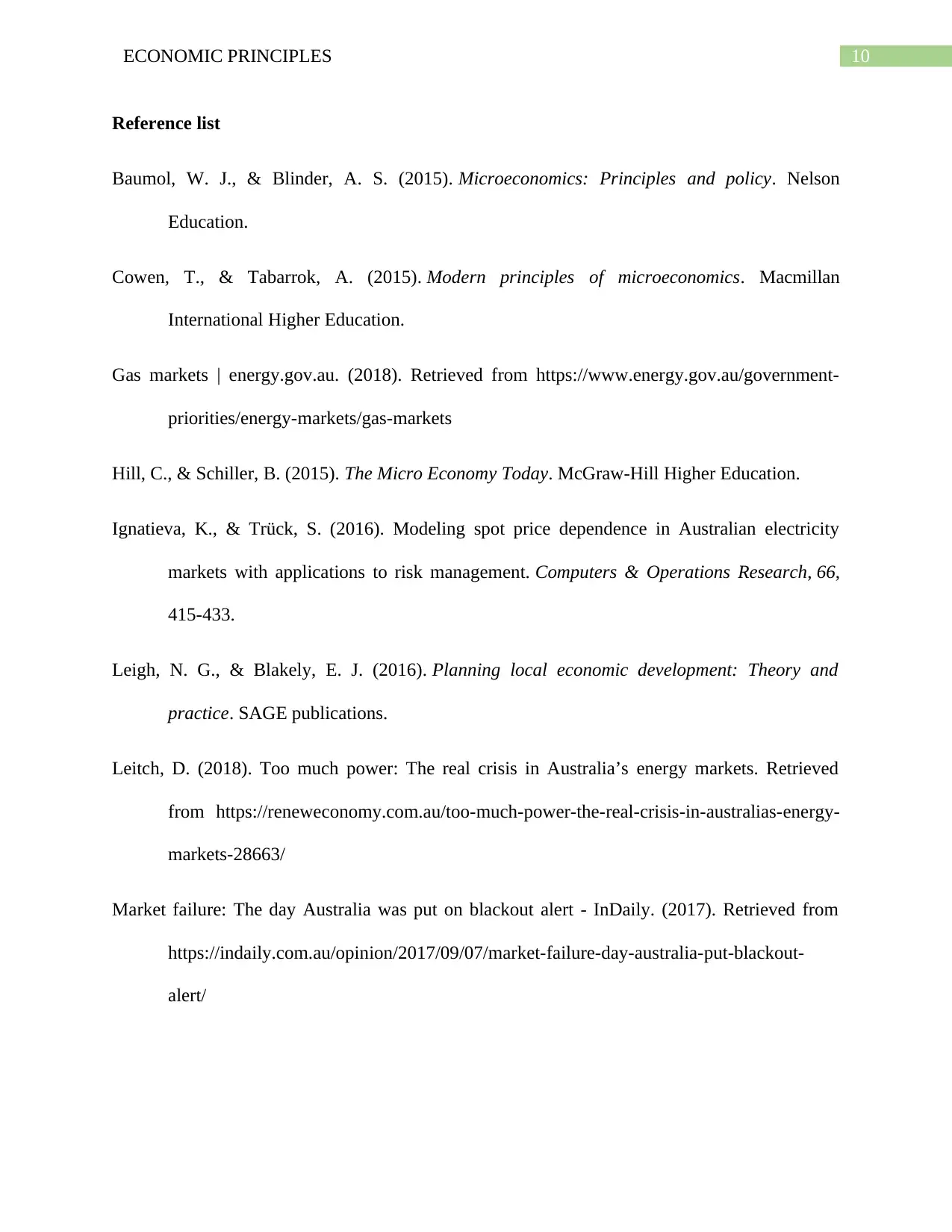
10ECONOMIC PRINCIPLES
Reference list
Baumol, W. J., & Blinder, A. S. (2015). Microeconomics: Principles and policy. Nelson
Education.
Cowen, T., & Tabarrok, A. (2015). Modern principles of microeconomics. Macmillan
International Higher Education.
Gas markets | energy.gov.au. (2018). Retrieved from https://www.energy.gov.au/government-
priorities/energy-markets/gas-markets
Hill, C., & Schiller, B. (2015). The Micro Economy Today. McGraw-Hill Higher Education.
Ignatieva, K., & Trück, S. (2016). Modeling spot price dependence in Australian electricity
markets with applications to risk management. Computers & Operations Research, 66,
415-433.
Leigh, N. G., & Blakely, E. J. (2016). Planning local economic development: Theory and
practice. SAGE publications.
Leitch, D. (2018). Too much power: The real crisis in Australia’s energy markets. Retrieved
from https://reneweconomy.com.au/too-much-power-the-real-crisis-in-australias-energy-
markets-28663/
Market failure: The day Australia was put on blackout alert - InDaily. (2017). Retrieved from
https://indaily.com.au/opinion/2017/09/07/market-failure-day-australia-put-blackout-
alert/
Reference list
Baumol, W. J., & Blinder, A. S. (2015). Microeconomics: Principles and policy. Nelson
Education.
Cowen, T., & Tabarrok, A. (2015). Modern principles of microeconomics. Macmillan
International Higher Education.
Gas markets | energy.gov.au. (2018). Retrieved from https://www.energy.gov.au/government-
priorities/energy-markets/gas-markets
Hill, C., & Schiller, B. (2015). The Micro Economy Today. McGraw-Hill Higher Education.
Ignatieva, K., & Trück, S. (2016). Modeling spot price dependence in Australian electricity
markets with applications to risk management. Computers & Operations Research, 66,
415-433.
Leigh, N. G., & Blakely, E. J. (2016). Planning local economic development: Theory and
practice. SAGE publications.
Leitch, D. (2018). Too much power: The real crisis in Australia’s energy markets. Retrieved
from https://reneweconomy.com.au/too-much-power-the-real-crisis-in-australias-energy-
markets-28663/
Market failure: The day Australia was put on blackout alert - InDaily. (2017). Retrieved from
https://indaily.com.au/opinion/2017/09/07/market-failure-day-australia-put-blackout-
alert/
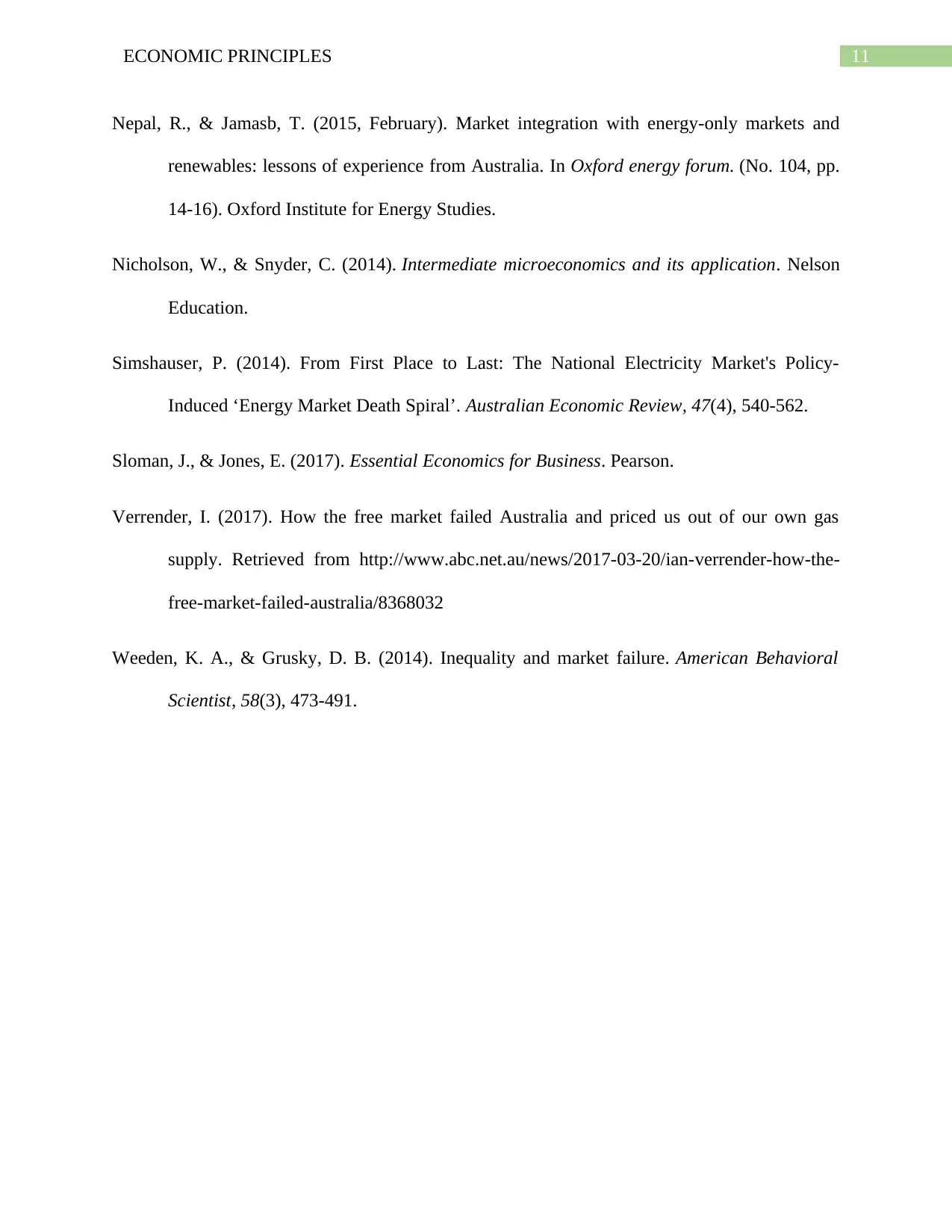
11ECONOMIC PRINCIPLES
Nepal, R., & Jamasb, T. (2015, February). Market integration with energy-only markets and
renewables: lessons of experience from Australia. In Oxford energy forum. (No. 104, pp.
14-16). Oxford Institute for Energy Studies.
Nicholson, W., & Snyder, C. (2014). Intermediate microeconomics and its application. Nelson
Education.
Simshauser, P. (2014). From First Place to Last: The National Electricity Market's Policy‐
Induced ‘Energy Market Death Spiral’. Australian Economic Review, 47(4), 540-562.
Sloman, J., & Jones, E. (2017). Essential Economics for Business. Pearson.
Verrender, I. (2017). How the free market failed Australia and priced us out of our own gas
supply. Retrieved from http://www.abc.net.au/news/2017-03-20/ian-verrender-how-the-
free-market-failed-australia/8368032
Weeden, K. A., & Grusky, D. B. (2014). Inequality and market failure. American Behavioral
Scientist, 58(3), 473-491.
Nepal, R., & Jamasb, T. (2015, February). Market integration with energy-only markets and
renewables: lessons of experience from Australia. In Oxford energy forum. (No. 104, pp.
14-16). Oxford Institute for Energy Studies.
Nicholson, W., & Snyder, C. (2014). Intermediate microeconomics and its application. Nelson
Education.
Simshauser, P. (2014). From First Place to Last: The National Electricity Market's Policy‐
Induced ‘Energy Market Death Spiral’. Australian Economic Review, 47(4), 540-562.
Sloman, J., & Jones, E. (2017). Essential Economics for Business. Pearson.
Verrender, I. (2017). How the free market failed Australia and priced us out of our own gas
supply. Retrieved from http://www.abc.net.au/news/2017-03-20/ian-verrender-how-the-
free-market-failed-australia/8368032
Weeden, K. A., & Grusky, D. B. (2014). Inequality and market failure. American Behavioral
Scientist, 58(3), 473-491.
⊘ This is a preview!⊘
Do you want full access?
Subscribe today to unlock all pages.

Trusted by 1+ million students worldwide
1 out of 12
Related Documents
Your All-in-One AI-Powered Toolkit for Academic Success.
+13062052269
info@desklib.com
Available 24*7 on WhatsApp / Email
![[object Object]](/_next/static/media/star-bottom.7253800d.svg)
Unlock your academic potential
Copyright © 2020–2025 A2Z Services. All Rights Reserved. Developed and managed by ZUCOL.





